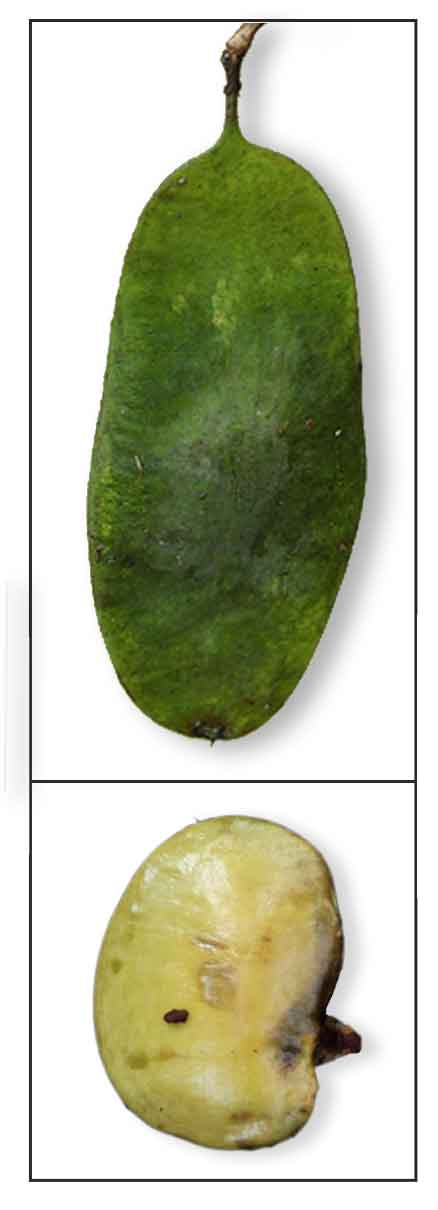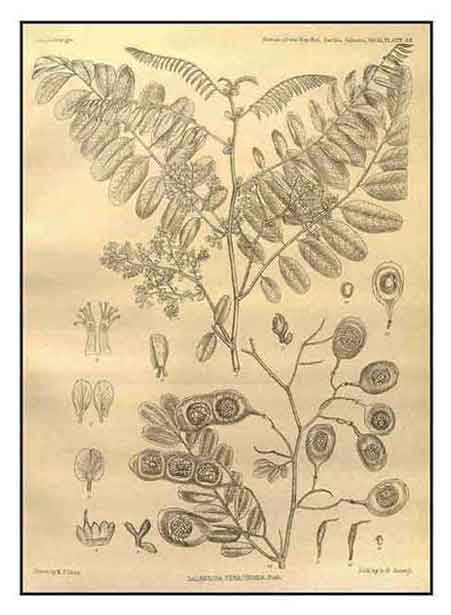 Gen info Gen info
• Dalbergia is a large genus of small to medium-sized trees, shrubs, and lianas in the pea family Fabaceae, subfamily Faboideae. The genus has wide distribution, native to the tropical regions of Central and South America, Africa, Madagascar, and Southern Asia. (16)
• Dalbergia stipulacea is a scrambling shrub or liana that grows primarily in seasonally dry tropical biome. (7)
Botany
• Balibagan is a climbing shrub reaching a height of several meters. Younger parts are covered with brown hairs, often becoming nearly smooth with age. Leaves are pinnate, 10 to 20 centimeters long, and made up of 15 to 21 leaflets. Leaflets are elliptic-oblong or oblong, 1.5 to 4 centimeters long. Flowers are pink, white, or yellowish, about 5 to 7 centimeters long, and borne in large numbers in axillary and terminal panicles. Pods are oblong to strap-shaped, 3 to 7 centimeters long, and 1.5 centimeters or less wide, and contain 1 to 3 seeds, being thin except where the seeds occur.
Distribution
- Native to the Philippines. (4)
-
In thickets and secondary forests at low and medium altitudes from northern Luzon to Palawan and Mindanao.
- Also native to Assam, Bangladesh, Cambodia, China South-Central, East Himalaya, Laos, Myanmar, Nepal, Thailand, Vietnam. (7)
 Constituents Constituents
- Roots and leaves yielded stipulin and luteolin 4'-rutinoside.
- Study of stems isolated two new compounds, dalpulanone (1) and 2-hydroxyisomucronustyrene (2), along with 14 other known compounds (3-16). (see study below) (11)
- Study of crude methanolic extract of roots isolated six known compounds including two pterocarpan derivatives: medicarpin (1) and nitiducarpin (2), two isoflavone derivatives, formononetin (3) and biochanin A (4), and two isoflavone derivatives, nitidulan (5) and dallvelutinane A (6).
(13)
- In a study of four medicinal plants, D. stipulacea showed highest total phenol content with 201.1 ± 0.31 mg GAE/gm, and total highest tannin content with 190.53 ± 0.28 mg.
Flavonoid content was 43.73 ± 1/43 mg CE/gm. (15)
- Phytochemical screening of methanol (M), chloroform (C) and petroleum ether (PE) extracts yielded:
alkaloids (M, C, PE), phytosterol (M, PE), phenol (M. C. PE), tannins (M, PE), flavonoid (<. C, PE), terpenoid (M. C. PE) and glycosides (M, PE), with absence of saponin. (15)
- Study of hexane extract of roots isolated five new compounds, dalpulapans A-E (1-5), along with seven known compounds (6-12):
R,R-velucarpin A (6), R,R-velucarpin C (7), taepeenin A (8),taepeenin E (9), pteroloterin A (10), nortaepeenin A (11) and 2-allyl-1,4-dimethoxy-benzene (12). (see study below) (17)
- Study of MeOH crude extract of roots of Ds isolated two previously undescribed compounds, dalpulapans F and G (1 and 2), along with 11 known compounds. Dalpulapan F is a rare isoflavone-quinone derivative. (see study below) (20)
- Study of stems isolated two new compounds, dalpulanone (1) and 2-hydroxyisomucronustyrene (2), along with 14 known compounds (3-16). (see study below) (21)
- GC-MS study of crude methanolic extract of leaves and fractions identified and characterized a total of 44 phytoconstituents,
with most prominent compounds of 3-O-Methyl-D-glucose (22.80 %), 8,11,14-Docosatrienoic acid, methyl ester (19.86 %), pentadecanoic acid, methyl ester (14.17 %), 13-docosenamide (6.62 %), nonadecanoic acid, methyl ester (4.62 %), and phytol (3.04 %). Other promising constituents were pantolactone, aromandendrene, D-allose, loliolide, neophytadiene, dibutyl phthalate, kolavenol, and squalene. (see study below) (22)
Properties
- Emmenagogue, abortive, piscicidal, vulnerary.
- Studies have shown antidiarrheal, anthelmintic, anti-inflammatory, anti-arthritic, thrombolytic, antifungal, antibacterial, cytotoxicity, anticancer, analgesic, hypoglycemic properties.
 Parts used Parts used
Fruit, stem, bark, leaves, roots.
Uses
Edibility
- No information found on edibility.
Folkloric
- Decoction or infusion of the wood and roots used as emmenagogue.
- In excessive doses, used as abortive.
- In Bangladesh, roots and leaves used in gonorrhea and aphthae.
-
Paste made from fruit and leaves applied to wounds and sores.
- In India, bark use to prevent dental cavities. (15)
Others
- Fish poison: Bark and roots used for poisoning fish.
In Nepal, roots used as piscicidal.
- Dental ritual: Plant used by the Maring tribe of Manipur, India, in the age-long tradition of blackening of teeth called Ha-sang. (11)
- Insecticide: In India, bark used as insecticide.
Studies
• Flavone Glycoside: Study yielded a new luteolin 4′-rutinoside and luteolin from the leaves of Dalbergia stipulacea. (1)
• Antidiarrheal / Anthelmintic / Leaves: Study evaluated a leaf extract for antidiarrheal and anthelmintic activity. At maximum concentration of 400 mg/kg, there was 42.22% inhibition compared to loperamide at 62.23%. Anthelmintic analysis using Panagrellus redivivus worms showed dose dependent activity. At highest dose of 2.5 mg, the extract paralyzed the experimental worm in 5.5 ± 1.323 min, with death in 23.93 ± 1.901 min. (8)
• Anti-Inflammatory / Thrombolytic: Study evaluated methanolic extracts of Dalbergia stipulacea and Hymendictyon excelsium for anti-inflammatory activity by HRBC (human RBC membrane stabilization method), anti-arthritic activity by inhibition of protein denaturation, and antithrombotic activity. Results showed notable anti-inflammatory activity and remarkable anti-arthritic and anti-thrombotic properties. Maximum membrane stabilization of D. stipulacea was 72.33 ±1.32% at a dose of 1000 µg and protein denaturation of 73.50 ± 1.32% at the same dose. Compared to Streptokinase for anti-thrombotic activity, it was close to standard with p<0.001 at 46.79 ±2.43%. (10)
• Antimicrobial / Leaves: Study evaluated the in vitro antimicrobial activity of extracts and isolated compound of Dalbergia stipulacea leaves. N-butanol fractionation yielded a flavonoid glycoside compound, luteolin 4'-rutinoside. Various extracts and isolated compound showed pronounced antibacterial and antifungal activities against four bacteria (Clostridium acetobutylinium, Bacillus subtilis, Streptococcus mutans, and Pseudomonas sp.) and one fungus (Candida albicans). Results suggest an antimicrobial agent with potential application in food, pharmaceutical, and bio-pesticide industries. (12)
• Antifungal / Stems: Study of stems isolated two new compounds, dalpulanone (1) and 2-hydroxyisomucronustyrene (2), along with 14 other known compounds. Compound 4 exhibited the strongest antifungal activity against Pythium insidiosum and had higher activity than standard Amphotericin-B. (see constituents above) (14)
• Dalpulapans Cytotoxicity Against Cancer Cell Lines / Roots: Study of hexane extract of roots isolated five new compounds, dalpulapans A-E (1-5), which were evaluated for cytotoxicity activity against HeLa, A549 and normal cell lines by MTT assay. Compound 6, R,R-velucarpin A, was most activie against HeLa with IC50 of 10.0 µM, and showing weak cytotoxicity against normal cells (29.20 µM). (see constituents above) (17)
• Olibergin A / Cytotoxicity Against Cancer Cell Lines / Stems: Fifteen derivatives were synthesized from olibergin A, a major isoflavonoid isolated from stems of Ds. All the compounds were evaluated for cytotoxicity against HCT-116, HT-29, MCF-7 and vero cell lines using MTT assay. Cytotoxicity testing showed compound 5 (5-hydroxy-7,2′,4′,5′-tetramethoxyisoflavone) to be most active with IC50s of 19.03, 10.83, 12.53, and 13.53 µM, respectively. Compound 5 showed two times less toxicity against vero cells than cisplatin standard (IC50 6.55 µM) while 5 and cisplatin exhibited nearly equal cytotoxicity against MCF-7 cell line. Compound 10 showed cytotoxicity againt HCT-116 cell line, and compound 13 showed cytotoxicity against HT-29 cells. Results showed compounds with potential as anticancer agents against HCT-116, HT-29, and MCF-7 cell lines. (18)
• Analgesic / Hypoglycemic: Study evaluated methanolic extracts of D. stipulacea for analgesic and hypoglycemic effects, utilizing in-silico molecular docking and ADME to evaluated oral bioavailability and binding affinity. Methanolic extract doses of 200 and 400 mg/kg demonstrated significant analgesic effects with 46.4% and 56.8% inhibition of acetic acid-induced writhing. ME dose of 400 mg/kg showed largest delay time increase of 14.76 at 120 minutes. There was also substantial reduction of plasma glucose levels in streptozotocin-induced hypoglycemia. (19)
• Cytotoxic Dalpulapan / Roots: Study of MeOH crude extract of roots of Ds isolated two previously undescribed compounds, dalpulapans F and G (1 and 2), along with 11 known compounds. Isoflavonoid 9 and rotenoid 13 exhibited most cytotoxicity againsst two cell lines: HepG2 and KKU-M156 cell lines. (20)
• Antifungal Against Pythium insidiosum / Stems: Study of stems isolated two new compounds, dalpulanone (1) and 2-hydroxyisomucronustyrene (2), along with 14 known compounds (3-16). Compound 4 exhibited strongest antifungal activity against Pythium insidiosum, higher activity than amphotericin-B standard. (21)
• Antioxidant / Cytotoxic / Anti-Thrombotic / Anti-Inflammatory / Antibacterial / Leaves: Study evaluated crude methanol extract of leaves for various biologic activities. Petroleum ether soluble fraction (PESF) yielded highest phenolic content (27.34 mg GAE/gm) and showed most effective DPPH free radical scavenging activity with IC50 of 3.87 µg/ml. The PESF also exhibited cytotoxicity with LC50 of 2.76 µg/mL compared to standard vincristine sulfate with LC50 of 0.45 µg/mL in brine shrimp lethality bioassay. The PESF exhibited most significant suppression of heat-induced hemolysis (32.61%) and hypotonic solution-induced hemolysis (33.86%) respectively. The AQSF showed highest % of clot lysis (38.61%). The ME and fractions showed promising antibacterial properties with ZOI of 6-25 mm compared to ciprofloxacin with 17-37 mm. (see constituents above) (22)
Availability
Wild-crafted.
|

![]()



 Gen info
Gen info
 Parts used
Parts used